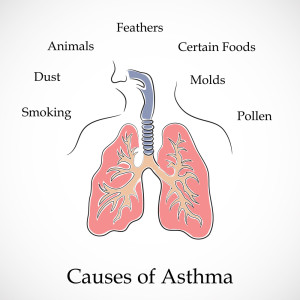Asthma diagnosis involves a number of procedures where the physician measures the air flow through the airways and the blood oxygenation.
Asthma is a lung disease where airway resistance shows an increase. The physician makes a diagnosis of asthma with the help of spirometry.
In particular, the forced vital capacity (FVC) and the forced expiratory volume in 1 second (FEV1 ) are important items to measure. A simpler home test is to measure the peak expiratory flow rate (PEF), which can be measured with a simple peak flow meter. The results are interpreted with the help of flow meter charts where sex and age is worked in.
Assessing pulmonary function
It is important for the doctor to assess the FEV1 /FVC ratio, as the size of the reduction of this is proportional to the severity of the asthma. The spirometry machine prints this out automatically. Also, if there is no reduction in this ratio, there might be another lung disease present (a restrictive airway problem, different from asthma). Using spirometry these flow-volume loops were recorded, which allow the lung specialist and the doctor to see how restrictive the airways are.
Other tests are X-rays, arterial blood gases and possibly CT and MRI scans in special cases that occasionally would be needed (see appropriate links in the table on Special procedures for lung diseases.
Allergy testing
Allergy testing is another important aspect for patients with inhalation allergies or food allergies who have asthma. It may be that these patients should be on allergy shots, if the treating physician or the specialist feels that this would be helpful. Many asthma patients can be stabilized with allergy shots to the point where a stage IV asthma condition can convert into a stage II or III asthma, which will be a lot easier to control with medication from then on.
People who are sensitized to peanut protein can get anaphylactic reactions including asthma, even from traces of peanut products.
References
1. Noble: Textbook of Primary Care Medicine, 3rd ed., Copyright © 2001 Mosby, Inc.
2. National Asthma Education and Prevention Program. Expert Panel Report II. National Heart, Lung and Blood Institute, 1997.
3. Rakel: Conn’s Current Therapy 2002, 54th ed., Copyright © 2002 W. B. Saunders Company
4. Murray & Nadel: Textbook of Respiratory Medicine, 3rd ed., Copyright © 2000 W. B. Saunders Company
5. Behrman: Nelson Textbook of Pediatrics, 16th ed., Copyright © 2000 W. B. Saunders Company
6. Merck Manual : Asthma (thanks to www.merckmanuals.com for this link).
7. Goldman: Cecil Textbook of Medicine, 21st ed., Copyright © 2000 W. B. Saunders Company
8. Ferri: Ferri’s Clinical Advisor: Instant Diagnosis and Treatment, 2004 ed., Copyright © 2004 Mosby, Inc.
9. Rakel: Conn’s Current Therapy 2004, 56th ed., Copyright © 2004 Elsevier







